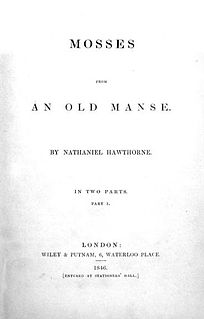 W
WNathaniel Hawthorne was an American novelist, dark romantic, and short story writer. His works often focus on history, morality, and religion.
 W
WHawthorne is a book of literary criticism by Henry James published in 1879. The book was an insightful study of James' great predecessor Nathaniel Hawthorne. James gave extended consideration to each of Hawthorne's novels and a selection of his short stories. He also reviewed Hawthorne's life and some of his nonfiction. The book became somewhat controversial for a famous section where James enumerated the items of novelistic interest he thought were absent from American life.
 W
W"Hawthorne and His Mosses" (1850) is an essay and critical review by Herman Melville of the short story collection Mosses from an Old Manse written by Nathaniel Hawthorne in 1846. Published pseudonymously by "a Virginian spending July in Vermont", it appeared in The Literary World magazine in two issues: August 17 and August 24, 1850. An early, literary expression of the mid-nineteenth century Young America movement, the work has been cited as an important commentary on, and analysis of, the emerging "New American Literature."
 W
WThe House of the Seven Gables, made famous by American author Nathaniel Hawthorne's novel The House of the Seven Gables (1851), is a 1668 colonial mansion in Salem, Massachusetts, named for its gables. The house is now a non-profit museum, with an admission fee charged for tours, as well as an active settlement house with programs for children. It was built for Captain John Turner and stayed with the family for three generations.
 W
WL. Brooks Leavitt (1878–1941) was an investment banker and antiquarian book collector who served as an overseer of Bowdoin College, to whose library he donated part of his collection of rare books and manuscripts. Born in Wilton, Maine, to a father who was a stagecoach driver who died when Leavitt was young, Brooks Leavitt was an aesthete turned banker whom Maine's poet laureate later eulogized at his funeral.
 W
WThe Nathaniel Hawthorne Birthplace is the home where American author Nathaniel Hawthorne was born. It is located at 27 Hardy Street but accessible through 54 Turner Street, Salem, Massachusetts. The house is now a nonprofit museum along with the House of the Seven Gables immediately adjacent; an admission fee is charged.
 W
WThe Nathaniel Hawthorne Boyhood Home is a historic house at Raymond Cape Road and Hawthorne Road in Raymond, Maine. Built about 1812, the house was the childhood home of author Nathaniel Hawthorne. Its interior now much altered, it serves as a function space for a community organization dedicated to its preservation. It was listed on the National Register of Historic Places in 1969.
 W
WThe Old Manse is a historic manse in Concord, Massachusetts, United States famous for its American historical and literary associations. It is open to the public as a nonprofit museum owned and operated by the Trustees of Reservations. The house is located on Monument Street, with the Concord River just behind it. The property neighbors the North Bridge, a part of Minute Man National Historical Park.
 W
WThe Wayside is a historic house in Concord, Massachusetts. The earliest part of the home may date to 1717. Later it successively became the home of the young Louisa May Alcott and her family, who named it Hillside, author Nathaniel Hawthorne and his family, and children's writer Margaret Sidney. It became the first site with literary associations acquired by the National Park Service and is now open to the public as part of Minute Man National Historical Park.